Image source: "People Sitting at the Table", by Tima Miroshnichenko, licensed under Free to Use
In today's fast-paced business landscape, building a loyal customer base has become an indispensable goal for any company looking to stay afloat.
Loyalty marketing can be a game-changer for businesses seeking to incentivize repeat purchases and cultivate lasting relationships with customers.
If you're considering implementing a customer loyalty program but don't know where to start, don't worry. In this post, we'll provide you with 7 essential strategies that have been tested and proven to help businesses like yours create effective and successful loyalty programs.
By the end of this article, you'll have a clear understanding of how to create a customer loyalty program that resonates with your customers and keeps them coming back for more.
So, let's jump right in and explore the key ingredients of a winning customer loyalty program!
Define the Objective(s) for Your Program (make sure it aligns with your business goals)
The first, but also the most critical, step when launching a customer loyalty program is to clearly understand what you're trying to achieve with it. Defining your program's objectives will help you stay focused on the results you want to accomplish and ensure your program aligns with your overall business goals.
There are several objectives you may have for your loyalty program. For instance, you may want to increase customers' purchase frequency and value by incentivizing them to spend more. Alternatively, you may be looking to reduce customer churn by keeping your existing customers engaged and motivated to continue doing business with you. You may also be interested in enhancing customer engagement, building brand affinity, or gathering customer data and insights.
Once you've defined your objective(s), you can start designing your loyalty program to align with them.
Let's say you want to increase purchase frequency and value. In this case, you may offer rewards or discounts for customers who spend a certain amount or make a specific number of purchases. On the other hand, if you're looking to reduce churn, you may offer perks to customers who have been with you for a certain amount of time or who have made repeat purchases.
By defining your objectives and aligning your program with them, you can create a customer loyalty program that delivers measurable results and helps you achieve your business goals.
Example: Coinbase
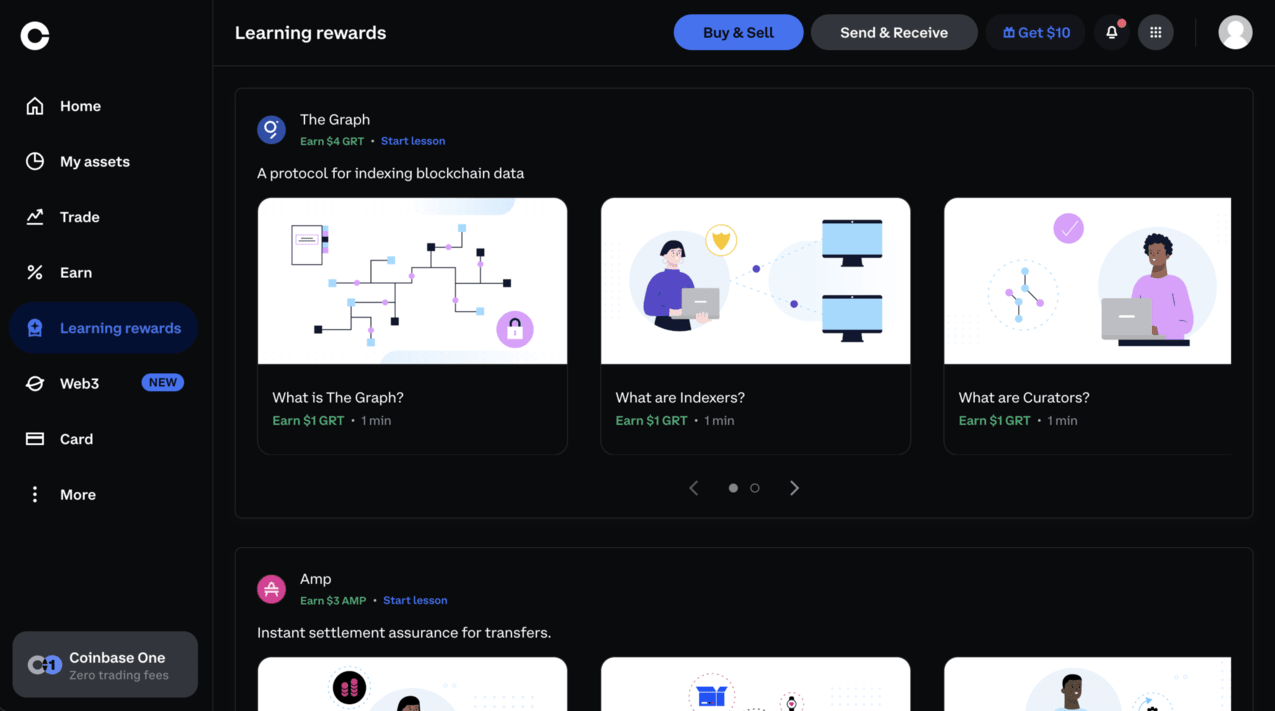
Image source: Coinbase
Coinbase, one of the largest cryptocurrency exchanges, offers a rewards program for its customers who complete educational content. By watching videos and taking quizzes, users can earn tokens that can be used to trade for other cryptocurrencies. Coinbase's objective is very straightforward: to motivate customers to learn more about how specific cryptocurrencies work. The idea behind this objective is that the more customers educate themselves on cryptocurrencies, the more they will be willing to invest in them.
Identify Your Target Audience (dive deep into customer data)
You can't build a customer loyalty program without knowing who you are building it for. That's why it's critical that, before anything else, you identify your target audience. This is the next step for how to create a loyalty program for customers. Knowing who your customers are and what motivates them to make purchases can help you design a loyalty program that resonates with them and drives engagement.
One effective way to identify your target audience is to leverage customer data.
You can collect customer data from a variety of sources, such as website analytics, sales, and customer conversations. The goal is to better understand customer behavior and preferences, which can inform the design of your customer loyalty program.
By collecting and properly analyzing customer data, you can gain valuable insights into your customers' behavior and preferences, such as their purchase history, product preferences, and communication preferences. This information can be used to design targeted loyalty programs that incentivize customers to engage with your brand and improve customer retention.
For instance, you can use purchase history data to identify your most loyal customers and offer them exclusive rewards or discounts. You can also use major milestone data, such as birthdays or anniversaries, to create targeted reward programs that incentivize customers to make purchases during special occasions.
Example: SoFi
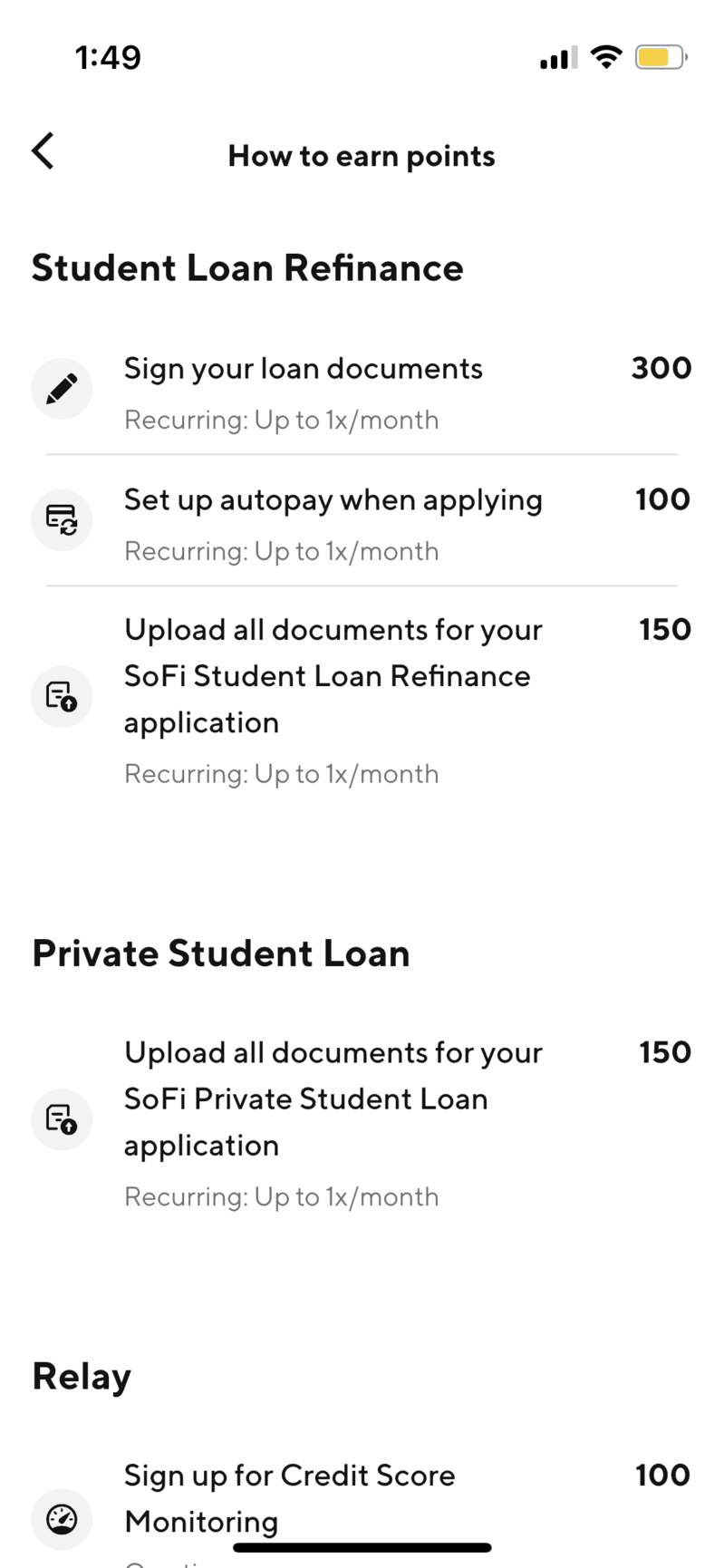
Image source: SoFi
Let's take SoFi as an example, a popular personal finance platform. By leveraging customer data to identify its target audience's preferences and behavior, SoFi was able to create a loyalty program that aligns with customers' interests. Users can earn points by enrolling in SoFi Member Rewards, logging into the app, referring friends, and spending on their SoFi credit card. These points can then be redeemed for cash equivalents or other rewards.
Choose the Right Type of Customer Loyalty Program (one that resonates with your audience)
When it comes to how to create a loyalty program, there are many different types to choose from. Rewards should incentivize and appeal to customers but also align with your business offerings.
Some of the most common types of loyalty programs include:
- Points-Based Loyalty Programs: These programs reward customers based on actions like referrals, repeat purchases, and subscriptions. Customers can accumulate points and redeem them for rewards like discounts or free trials.
- Tiered Loyalty Programs: Tiered loyalty programs offer customers different benefits based on their spending. Customers who spend more receive higher levels of rewards, such as access to more advanced features or free services.
- Subscription-Based Programs: These programs require customers to pay a fee to access benefits such as free shipping, access to exclusive events, or special discounts.
- Cash-Back Programs: Cash-back programs are designed to give customers a percentage of their purchases back in cash or credits. These programs are often linked to a specific credit or debit card, and rewards are automatically applied to the customer's account.
- Punch Card Programs: Punch card programs are a simple way to reward customers for their loyalty. Customers receive a card with spaces that are punched each time they make a purchase. After a certain number of punches, the customer can redeem their card for a reward.
- Value-Based Loyalty Programs: These programs showcase a brand's values and donate a portion of sales to specific charities or causes. This can be a powerful way to connect with customers who share similar values.
- Gamified Loyalty Programs: Gamified loyalty programs offer games or challenges to keep customers engaged. Customers can earn rewards by completing certain tasks or achieving specific milestones.
Example: RobinHood
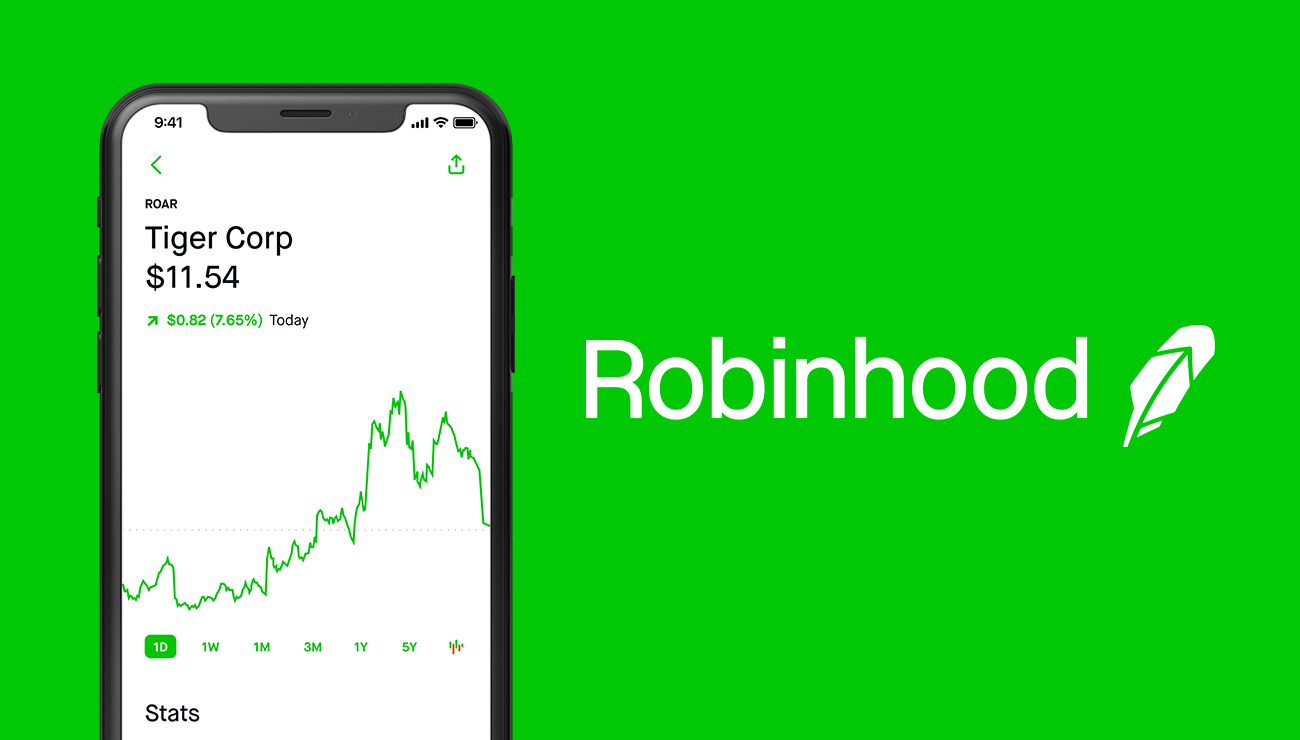
Image source: Robinhood
One example of a successful loyalty program is Robinhood, the popular stock trading app that offers a tiered loyalty program. Robinhood's loyalty program is based on the size of the deposit customers make on the platform. Depending on the size of the deposit, customers can earn anywhere from $10 to $250. This incentivizes users to invest more money into the platform while also giving them a tangible reward for doing so.
Set the Guidelines for Earning and Redeeming Rewards (but don't overcomplicate it)
When it comes to customer loyalty programs, simplicity is key. Research suggests that "easy to use" and "easy to understand" programs are the main reasons why U.S. consumers participate in loyalty programs.
One of the biggest mistakes brands make with their loyalty programs is overcomplicating things by trying something different or ground-breaking. However, simple but well-planned loyalty programs are the ones customers are usually drawn to.
To create a loyalty program that customers find easy to use and understand, you should simplify every aspect of your rewards system. This includes:
- The enrollment process: Make this process as seamless as possible. Allow customers the option of enrolling via the web or mobile. Ask them to share only a few relevant details at this point. Don't overwhelm them with too many questions.
- The benefits: Make it easy for customers to understand the customer loyalty benefits that come with their membership. For example, if yours is a point-based loyalty program, make sure customers have clarity on how they can earn new points, where they can access their balance, and the ways in which they can use their points.
- The rewards redemption process: Ensure the rewards redemption process is straightforward. Make it easy for customers to redeem their rewards, whether it's through a mobile app or your company's website.
Example: Heap
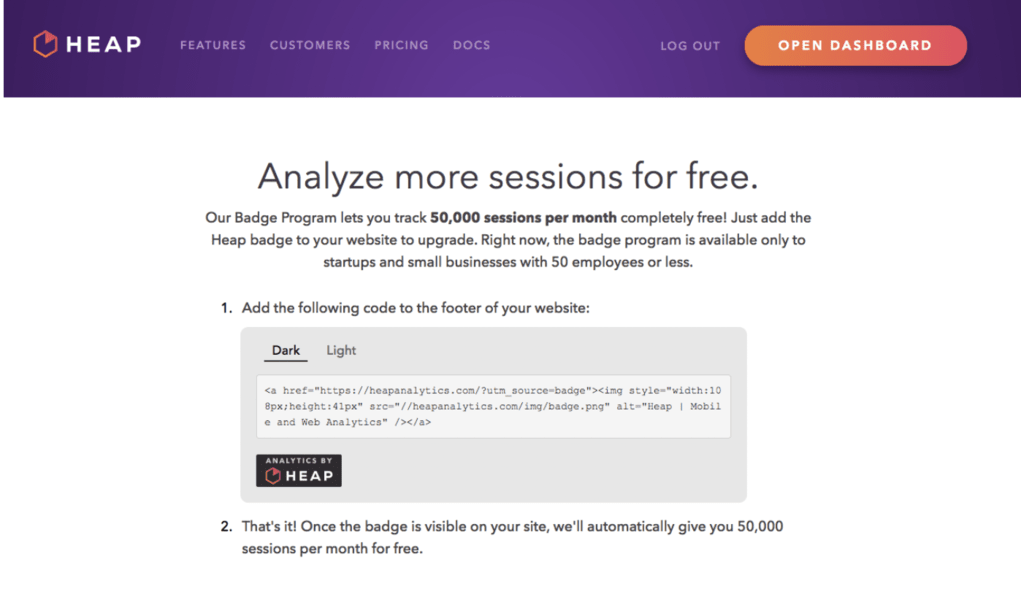
Image source: Heap
One example of a successful and straightforward loyalty program is Heap, a website analytics service that offers a simple rewards program to its customers.
The rules of Heap's loyalty program are very straightforward. Customers only need to add the Heap badge to their website to start earning rewards. Once they add the badge, they can gain access to 20,000 free sessions per month. This simplicity helps customers understand the benefits of the program and encourages them to participate.
Choose the Platform to Implement the Loyalty Program (to simplify the management process)
While managing a customer loyalty program manually may be doable if you have a small number of clients, it can quickly become overwhelming as your client base grows. This is where investing in a customer loyalty program software becomes critical.
Loyalty program software provides a centralized location to manage all aspects of the program, from rewards and points to customer information and analytics. This simplifies the tracking process, reduces errors associated with manual tracking, and saves valuable time.
One such loyalty program software platform is LoyaltySurf. By using a software platform like LoyaltySurf, companies can automate many of the processes involved in running the program, such as tracking rewards and sending out communications to customers. This can help streamline the program and make it more efficient, which can lead to higher levels of customer engagement and satisfaction.
LoyaltySurf provides a range of features that help businesses create, manage, and track customer loyalty programs. Businesses can easily create customized loyalty programs that align with their business objectives and target audience. LoyaltySurf's platform also provides real-time data and analytics to help businesses make informed decisions about their loyalty program.
Promote the Loyalty Program to Customers (don't skip this step)
Without effective promotion, your loyalty program may go unnoticed, leading to a missed opportunity to increase customer retention, boost sales, and build brand loyalty.
Some of the best ways to promote the program include:
- Emails campaigns: Email campaigns are an effective way to reach your customers and promote your loyalty program. The emails should announce the loyalty program, highlight the benefits, and encourage customers to sign-up.
- Website banners and landing pages: Your website is a key platform for promoting your loyalty program. Make it easy for your customers to sign up and learn more about your loyalty program by featuring prominent banners and landing pages on your website that showcase the program and its benefits.
- Social media: Leverage your social media channels to promote your loyalty program, emphasizing the rewards and benefits of participation and encouraging sign-ups. Additionally, you may want to consider utilizing paid social media ads to extend the reach of your promotions to a wider audience.
- In-app promotions: If you have a mobile app, use in-app promotions to encourage customers to join your loyalty program. This could include pop-up notifications or special in-app deals for loyalty program members.
Example: Trip.com
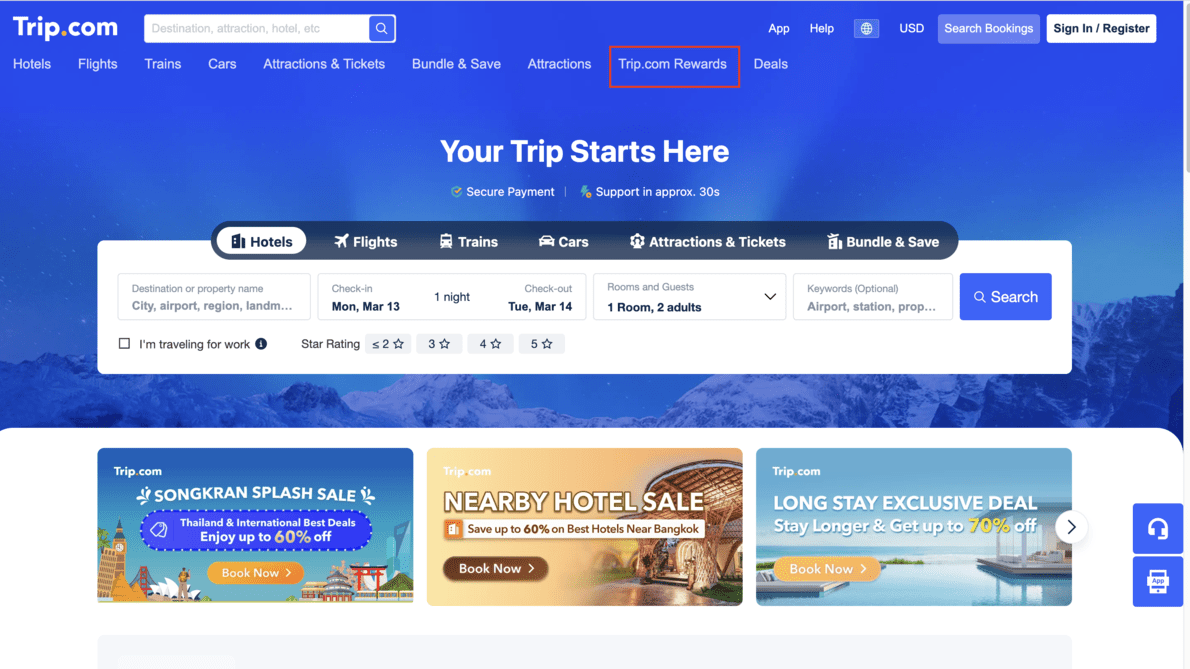
Image source: Trip
Trip, a travel booking site, offers a rewards program to its customers through a points system. Users can earn points by engaging with the platform in various ways, such as viewing, liking, and commenting on trips. These points can be redeemed for cash or used to purchase travel services. To promote the program, Trip features it prominently on its homepage menu and provides a dedicated page where customers can learn about the rules and benefits of the program in detail. This ensures that customers are aware of the loyalty program and can easily sign up to take advantage of the rewards and incentives offered.
Track the Performance of the Loyalty Program (and make necessary adjustments)
Tracking the performance of a loyalty program helps you measure your success. You'll be able to determine how well your loyalty program is performing and identify areas for improvement.
Here are a few methods:
- Setting KPIs: Setting Key Performance Indicators (KPIs) is a crucial step in tracking the performance of your customer loyalty program. This involves defining metrics that you want to measure, such as customer retention rate, customer lifetime value, or redemption rate.
- Analyzing Program Data: One of the most effective ways to track the performance of your customer loyalty program is by analyzing data from your loyalty program software. This data can help you to understand how customers are engaging with your program, which rewards are most popular, and which customers are most valuable to your business.
- Gathering Feedback: Another important strategy for tracking the performance of your customer loyalty program is by gathering feedback from your customers. This can include surveys, focus groups, or even one-on-one conversations.
- Evaluating the Program Regularly: Regularly evaluating your loyalty program is key to ensuring that it remains effective and meets the needs of your customers. This involves setting a regular cadence for program evaluation, such as every quarter or every six months.
- Adjusting Benefits and Rewards: Based on your program data, customer feedback, and KPIs, you may need to adjust your loyalty program benefits and rewards to ensure that they remain relevant and appealing to your customers.
Conclusion
Creating a customer loyalty program can be a highly effective way to increase customer retention, drive repeat purchases, and build brand loyalty. By following the 7 strategies on how to create a customer loyalty program, you can create a successful loyalty program that meets the needs and preferences of your customers.
We encourage all businesses to create a loyalty program and to utilize the strategies outlined in this post to ensure its success. By doing so, you can strengthen your relationship with customers, increase revenue, and differentiate yourself from your competitors.







